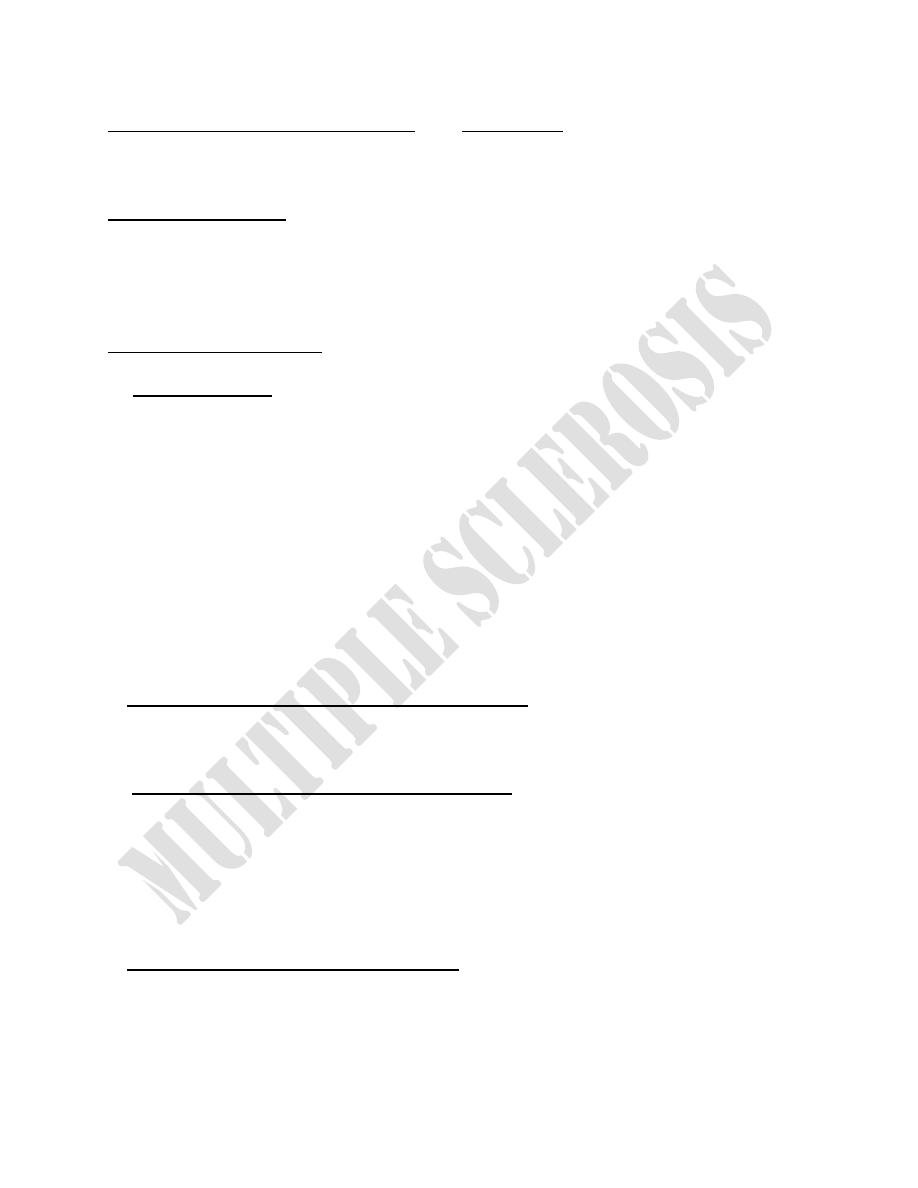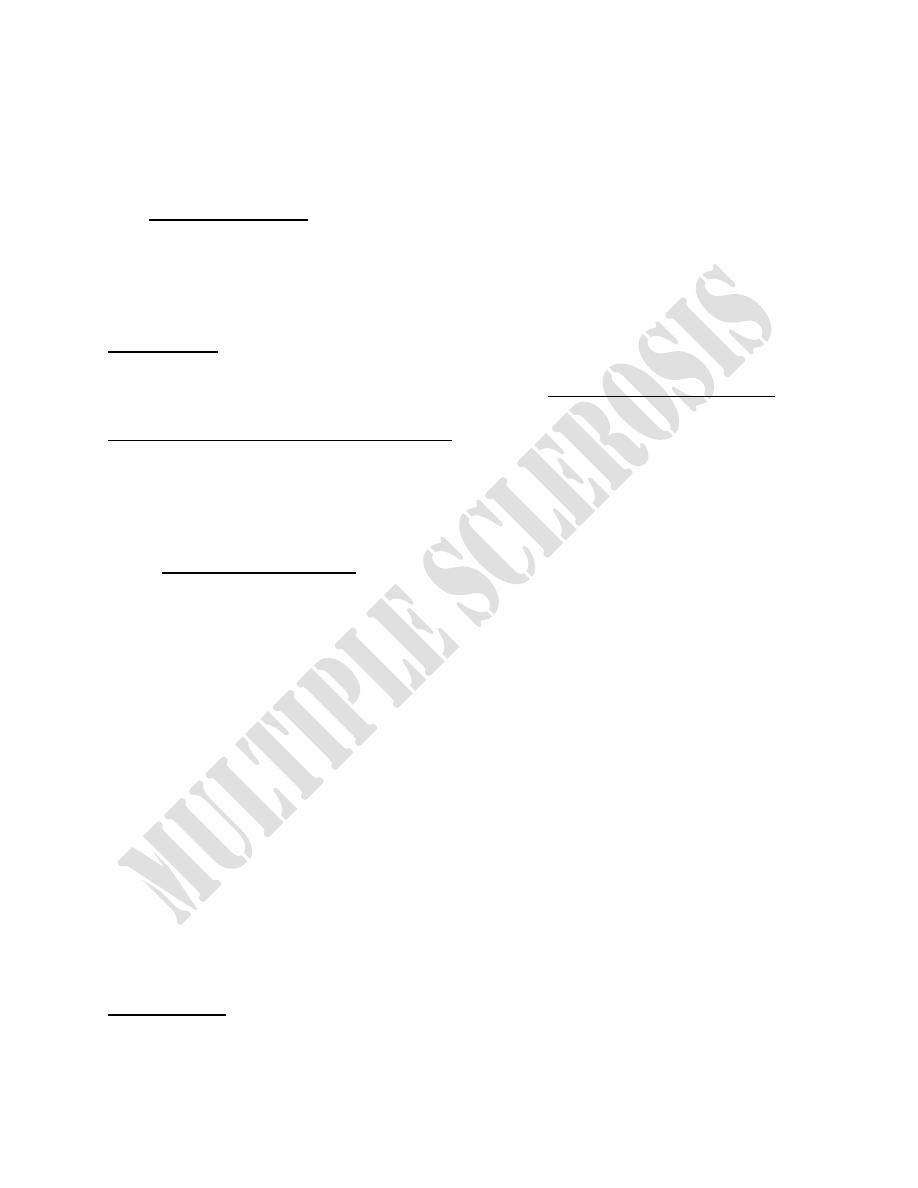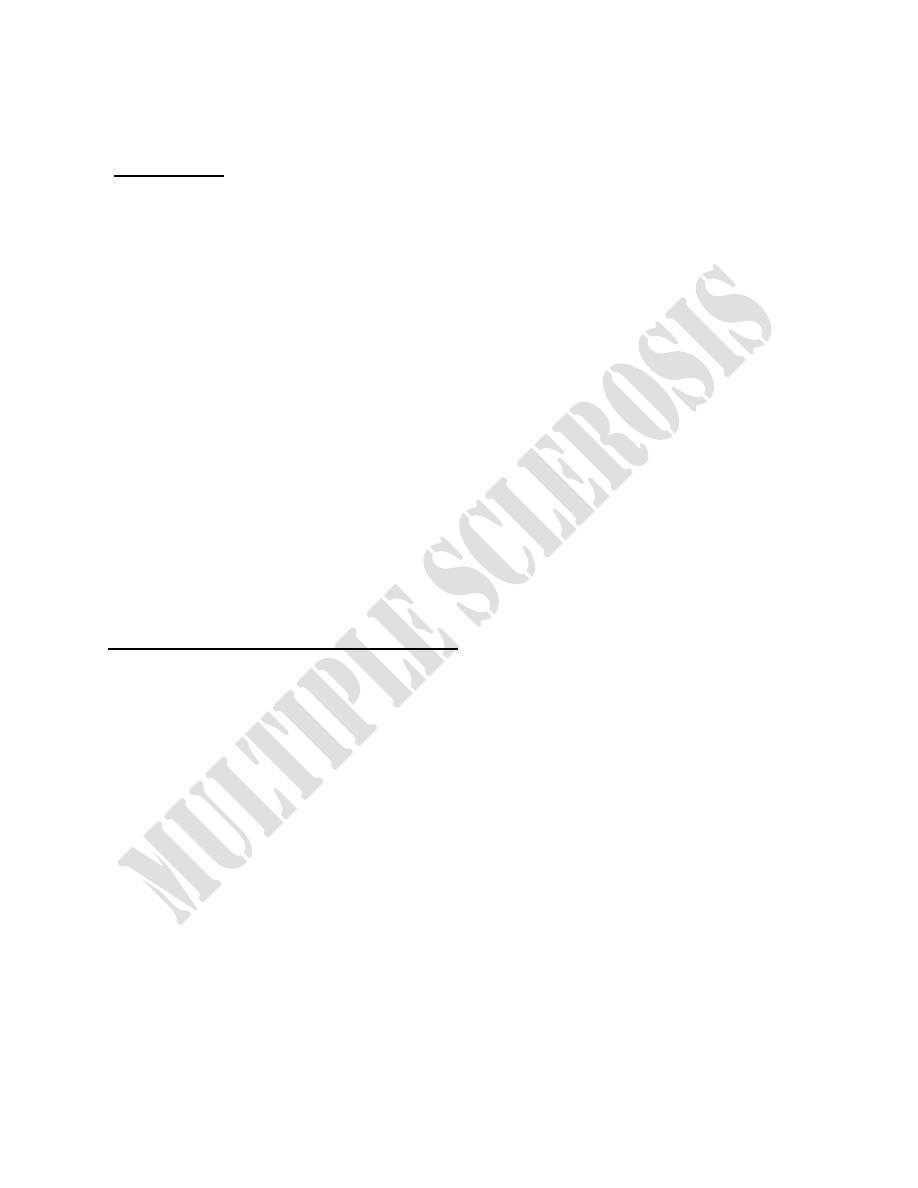
MULIPLE SCLEROSIS
Definition- is a demyelinating disease characterized by selective
destruction of CNS myelin.
It is second only to trauma as a cause of neurologic disability in early to
middle adulthood.
Epidemiology and Etiology-
It typically affects people between 20-40 years with female to male
ratio 2:1. Incidence varies with latitude and being low in equatorial areas
and higher in temperate zones of both hemispheres.
Studies suggest that multiple sclerosis is caused by interplay of multiple
genetic and environmental factors (viral, socioeconomic status).
Prevalence correlates with environmental factors, such as sunlight
exposure, vitamin D and exposure to Epstein–Barr virus (EBV).
Risk for first degree relative of the patient is 2-3%.
Pathology-
Multiple sclerosis is characterized by a triad of inflammation,
demyelination and gliosis (scarring). Inflammation starts with the entry of
activated T-lymphocytes through the blood brain barrier to recognize
myelin-derived antigens on the surface of CNS antigen-presenting cells,
the microglia; and undergo proliferation. The resulting cascade initiates
destruction of the oligodendrocyte- myelin.
The lesion of multiple sclerosis is called “plaque” which occurs most
commonly in the periventricular regions of the brain, optic nerves, the

subpial regions of the spinal cord and cerebellum.
Clinical features:
Demyelinating lesions cause symptoms and signs that usually come on
subacutely over days or weeks and resolve over weeks or months.
Common presentations are:
a- optic neuritis: gradual loss of vision in one eye with painful eye
movements and usually disc swelling on fundoscopy. When the disc
remains normal by fundoscopy, it is called” retro bulbar neuritis” (the
patient sees nothing and the doctor sees nothing).
Optic neuritis leads to afferent papillary defect (APD) - loss of direct and
consensual response to light stimulation of the affected eye- even after
resolution of symptoms.
b-relapsing- remitting sensory symtoms: burning pain or parasthesia
involving the extremities, face or trunk usually asymmetrical.
c- Subacute painless spinal cord lesion- including asymmetrical
paraparesis and Brown- Sequard Syndrome (ipsilateral motor weakness
and loss of proprioception and vibration with contra lateral loss
pain and temperature).
d-acute posterior fossa syndrome – mostly internuclear
ophthalmoplegia (failure of adduction of the ipsilateral eye with nystagmus
of the contralateral abducting eye), cerebellar ataxia, pseudobulbar palsy.

e- paroxysmal signs: like Lermitte’s sign( tingling in spine or limbs on
neck flexion), Uthoff sign (exaggeration of symptoms by heat) and
trigeminal neuralgia.
•
Significant intellectual impairment is unusual.
•
Three main clinical types of multiple sclerosis have been described:
1-
Relapsing-remitting
: accounts for 80%, and characterized by attacks
that generally evolve over days to weeks followed by variable recovery.
2-
Secondary progressive
: the patient experiences a steady deterioration
in function unassociated with acute attacks. Approximately 50% of
relapsing remitting disease will have developed secondary progressive
disease after 15 years.
3-
Primary progressive
: 20% of patients follow a slowly progressive course
from the start.
Investigations: there is no specific test for multiple sclerosis.
a- MRI is the most sensitive technique for imaging lesions in the brain and
spinal cord (especially with contrast) and in excluding other causes of
deficit.
b- Evoked Potential (EP) - visual EP can detect silent lesions in up to 70%
of patients, but auditory EP and somatosensory EP are seldom of

diagnostic value.
c- CSF study: may show lymphocytes predominance in the acute phase
and
oligoclonal bands
between attacks.CSF protein may be normal or
mildly elevated.
Diagnosis:
The diagnosis of multiple sclerosis requires
the demonstration of lesions
being disseminated in time and place
. It depends on the MACDONALD
CRITERIA.
•
Differential diagnosis:
1- Acute disseminated encephalomyelitis (ADEM).
2- CNS infections –neurobrucellosis, tuberculosis, neurosyphilis.
3- Behcet’s disease.
4- Connective tissue disease.
5- Antiphospholipid antibody
6- CNS vasculitis.
7- Vitamin B12 deficiency.
8- Neurosarcoidosis.
Treatment:

•
Acute relapse: pulses of methylprednisolone either i.v. 1gm/day
for 3-5 days or orally 500mg/day for 5 days shorten the duration of
the relapse.
•
Preventing relapses:
A- Interferon β1a and 1b reduces the number of relapses by 30%.
B- Glatiramer acetate.
C- dimethyl fumarate: oral
D- Fingolimode: oral
E- Teriflunamide: oral
E- natalizumab: monoclonal antibody.
E- metoxantrone: cytotoxic drug.
E- Others: azathioprine, cyclophosphamide.
F- I.V. immunoglobulin.
•
Symptomatic treatment
a- Spasticity – physiotherapy, baclofen (liorisal), tizanidine, botulinum toxin
Injection for focal spasticity.
b- Ataxia- INH, clonazepam.
c- Dysasthesias - carbamazepine, gabapentin, phenytoin, amitryptiline.
d- Bladder symptoms – intermittent self catheterization in paralytic bladder
and anticholinergics (imipramine or oxybutinin) in spastic bladder.
e- Fatigue – amantadine, modafinil or amitriptyline.
f- Impotence – sildenafil.

Prognosis : good prognosis is associated with
i- female gender
ii- complete recovery from the attack
iii- age less than 40 years.
iv- optic neuritis and sensory symptoms (rather than motor and cerebellar
symptoms).
v- relapsing-remitting disease.
Approximately 5% of patients die within 5 years of onset.
Other demyelinating diseases
ACUTE DISSEMINATED ENCEPHALOMYELITIS
•
This is an acute, usually monophasic, demyelinating condition.
•
It often occurs a week or so after a viral infection, especially
measles
and
chickenpox
, or following vaccination, suggesting that it is
immunologically mediated.
•
Clinical features include headache, vomiting, pyrexia, confusion and
meningism, with focal or multifocal brain and spinal cord signs.
Seizures
or coma may occur.
•
MRI shows multiple high-signal areas in a pattern similar to that of
multiple sclerosis, although often with larger areas of abnormality.
•
The disease may be fatal in the acute stages.

•
Treatment with high-dose intravenous methylprednisolone.
ACUTE TRANSVERSE MYELITIS
•
It is an acute, often monophasic, inflammatory demyelinating
disorder affecting the spinal cord over a variable number of
segments.
•
Patients may be of any age and present with a subacute paraparesis
with a sensory level, often with severe pain in the neck or back at the
onset.
•
MRI is needed to distinguish this from a compressive lesion of the
spinal cord.
•
Treatment is with high-dose intravenous methylprednisolone.
NEUROMYELITIS OPTICA (Devic’s disease)
It causes extensive myelitis with or without optic neuritis (unilateral or
bilateral).
The majority of cases are associated with an antibody to a neuronal
membrane channel, aquaporin 4.
Clinical deficits tend to recover less well than in MS, and the disease
may be more aggressive than multiple sclerosis.
